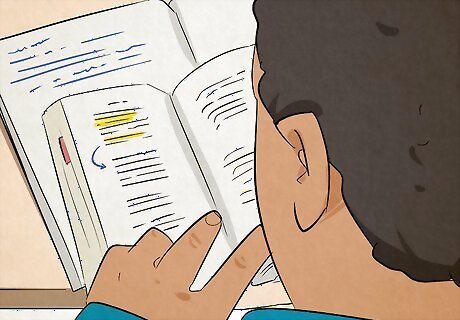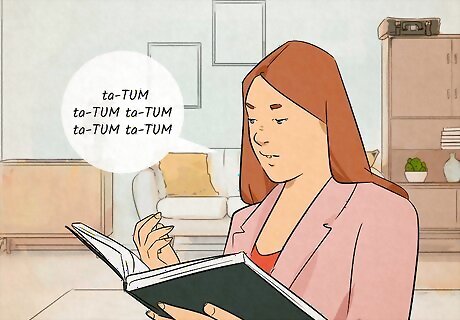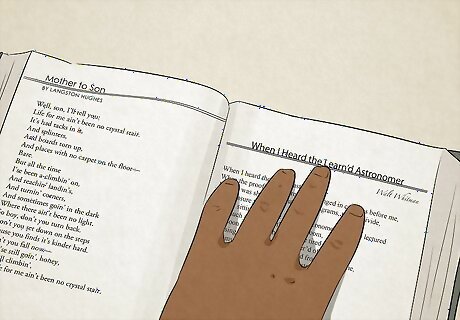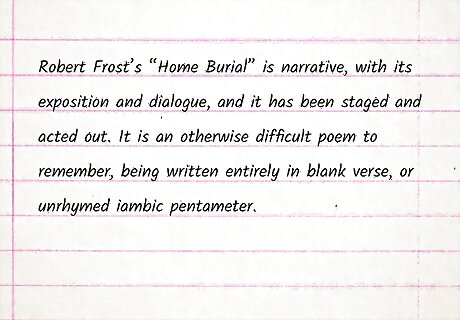
views
Memorizing a Formal Poem

Read the poem aloud several times. It’s important to remember that all poetry — whether it rhymes or not — comes from an oral and aural tradition, meaning that it’s meant to be spoken and heard. Before television, poetry was how people entertained themselves with storytelling. And in a time when literacy was not widespread, poetry took on certain characteristics — from rhyme schemes to metrical form — that helped people who couldn’t simply read the poem off a page to remember how the poem and story progressed. Before you even begin trying to memorize the poem, read it out loud to yourself several times. Don’t simply read the words off the page; try to perform the poem as though you were telling the story to a crowd of people. Lower your voice in the quiet moments, and get loud in the emphatic moments. Use hand gestures to highlight key passages. Be theatrical. It’s important that you read the poem out loud, rather than to yourself in your head. Hearing the poem with your ears will help you pick up on rhymes and rhythms that will help you memorize the poem.

Look up words you don’t understand. Poets are great lovers of words, so they often use words that we’re not familiar with. If you’re asked to memorize an older poem, you will likely run across archaic words or grammatical structures that you don’t understand. Figuring out what those words and sentences mean will help you memorize the poem later. Take John Donne’s “A Valediction: Forbidden Mourning” as an example. In the second stanza, you might have to look up the words “Tempest” (a storm), “profanation” (disrespecting something spiritual by making it secular and earthly), and “laity” (common people who don’t belong to the clergy or spiritual elite) to understand what the poet is trying to say. This stanza says, “Let’s be quiet instead of crying a lot and sighing all the time. If we told these petty commoners about our love, we’d be doing a disservice to how sacred it is.” Sometimes, it’s not the definitions of the words themselves that cause a problem, but the metaphoric use of the words. Look at stanza 3 of “A Valediction: Forbidden Mourning.” You may know what all of those words mean individually, but have trouble understanding what that stanza is about. The “Moving of the’ earth” in this case in an earthquake. An earthquake causes harm and frightens people, and people do their best to make sense of it in the aftermath. The “trepidation of the spheres” is the movement of the stars and planets in the sky. Those movements are far greater in scale, more violent, and, in popular mythology, have a far greater impact on the fate of people on earth. However, though those movements and their consequences are far greater than that of an earthquake, we lack “trepidation” of them, and fear silly little earthquakes instead. We are “innocent” or ignorant of the far greater movements that affect our lives, choosing to focus on unimportant details. This stanza builds the idea that the speaker’s love is unearthly — grander and more important than that of the “dull sublunary (under the moon, on the earth) lovers” in the next stanza. If you have trouble understanding the meaning of a poem, consult a study guide either from the library or online to help you along.

Learn and internalize the “story” in the poem. Once you’ve looked up all the unfamiliar words, wordings, and images, you need to learn the poem’s story. If you don’t understand what the poem’s about, you’ll have as much trouble memorizing it as you would have to try to memorize a string of completely unrelated words that have no meaning. Before you try to memorize the poem, you should be able to summarize its story easily and completely from memory. Don’t worry about the actual words in the poem at this point — just a summary of the content. Some poems are “narrative,” meaning that they tell an actual story. William Wordsworth’s “I Wandered Lonely As A Cloud” is a good example. In it, the narrator is wandering through nature when he comes across a field of daffodils. He then describes the daffodils: how they seem to dance in the breeze, how their numbers seemed to stretch like stars across the sky, how happy and joyful their dance seemed, and finally, how the memory of those flowers brings him joy in sad moments when he’s back at home, away from nature.

Look for connections between stanzas or sections. Not all poems are narrative and tell a clear story with plot points: this happened, then that happened. However, all poems are about something, and the best poems — the ones teachers tend to assign in class —develop and progress in some way. Even if there is no plot, try to figure out the meaning or message of the poem by understanding the connections between stanzas or sections. Look at Richard Wilbur’s “Year’s End” as an example. This poem begins with a clear setting: It’s New Year’s Eve (“the dying of the year”), and the speaker is on a street in a neighborhood looking through the window of a house, where he can just see the moving shapes through the frost on the glass. The majority of the poem progresses through associative imagery, in which one image leads to another purely by whatever association springs into the writer’s mind, rather than by logic or chronology, as it would in a story. So, in this poem, the frosted window from the first stanza makes the poet leap to the image of a frozen lake in the second; a frozen lake looks a little bit like a frosted window, after all. Frozen in the lake’s surface are the leaves which fell during the freezing process, which are now stuck to its surface, fluttering in the wind like perfect monuments. That perfection at the end of the second stanza is drawn into the third as “the perfection in the death of ferns.” Also drawn down is the idea of being frozen: just as the leaves were frozen in the lake as monuments in the second stanza, ferns are frozen as fossils in the third. Also frozen as fossils were mammoths, who lay preserved in ice. The preservation at the end of the third stanza is brought down to the fourth: the preservation of a dog in the ruins of Pompeii, a city that was obliterated by a volcanic eruption, but whose shapes were preserved by the volcanic ash. The final stanza draws from the idea of a sudden end at Pompeii, where people were frozen in place unexpectedly, never anticipating their sudden death. The final stanza brings us back to the scene from the first: it’s New Year’s Eve, the end of another year. As we “fray into the future,” the poem argues, we should consider all the “sudden ends” the poem has presented to us: the leaf caught in ice, the fossilized ferns and mammoths, the sudden, unexpected deaths at Pompeii. This poem might be difficult to memorize because it doesn’t have a chronological plot development. However, by understanding the associative way in which the stanzas are related to one another, you’ll be able to remember: looking through frosted windows on New Year’s Eve → leaf in a frozen lake as perfect monument → perfection of fossilized ferns and mammoths preserved in ice → the bodies preserved in volcanic ash at Pompeii → these sudden ends should be remembered now, at the end of the year, as we look forward to the next.

Figure out the poem’s meter. Meter is the rhythm of a line of poetry; it is composed of metrical feet, or units of syllables with their own distinct accentual patterns. For example, iambs are the most common metrical foot in English poetry. They have two syllables — the first unstressed, and the second stressed, resulting in a ta-TUM rhythm, as in the word “hel-LO.” Other common metrical feet include: the trochee (TUM-ti; MORN-ing), the dactyl (TUM-ti-ti; PO-et-ry), the anapest (ta-ta-TUM; ever-more), and the spondee (TUM-TUM; PRAISE HIM). In English, most poems rely on a largely iambic rhythm, though there can be a great deal of metrical variation. This variation is often found at important moments in the poem; look for variation at key moments in the story you memorized. The meter of a poem is often constrained by the number of feet in a line. For example, iambic pentameter means that the lines are composed of five (pent) iambs each: ta-TUM ta-TUM ta-TUM ta-TUM ta-TUM. An example of an iambic pentameter line from Shakespeare’s “Sonnet 18” is “Shall I compare thee to a summer’s day?” Diameter means there are two feet per line; trimeter has three feet; tetrameter has four; hexameter has six, and heptameter has seven. Very, very rarely will you see lines extend further than heptameter. Count out the syllables and rhythms in each line and determine what the meter of the poem is. This will help you learn the musical cadence of the poem. For example, there’s a big difference between a poem written in iambic tetrameter, like Tennyson’s “In Memoriam A.H.H.,” and one written in dactylic diameter, like Tennyson’s “The Charge of the Light Brigade.” As you did in the very first step, read the poem out loud several times, but pay special attention to the music and rhythm of the lines now. Read the poem several times until the music, including the metrical variations, feel as natural and predictable to you as that of your favorite song.

Memorize the poem’s formal structure. A formal poem, also known as metrical verse, is a poem that follows a pattern of some combination of rhyme, stanza length, and meter. You’ve already figured out the meter, but now you need to look at the rhyme scheme, which will in turn tell you how many lines are in each stanza. Look in an online study guide to see if your poem is an example of a particular form of poetry — a Petrarchan sonnet, for example, or a villanelle or sestina. It may be a nonce form, or a poem whose formal structure does not belong to an entire category of poems, but was instead invented by the poet for the purpose of this poem alone. There are many reliable online resources where you can learn more about the formal structure of the poem you are trying to memorize. By memorizing the formal structure of the poem, you will be able to jog your memory about what comes next if you get stuck while trying to recite a poem. For example, if you are trying to recite Edna St. Vincent Millay’s “Time does not bring relief; you all have lied,” but get stuck after the second line, you can remember that it’s a Petrarchan sonnet, which begins with a rhyme scheme of ABBA. Since the first line ends with “lied” and the second with “pain,” you know that the third line will end with a word that rhymes with “pain” and the fourth with a word that rhymes with “lied.” You can then recall the rhythmic music of the poem (iambic pentameter) to help you hum out the rhythm until the lines come back to you: “I miss him in the weeping of the rain; / I want him at the shrinking of the tide.”

Read the poem aloud again several times. This experience should be very different from the initial readings you did, because now you’ll have a much deeper understanding of the poem’s story, message, and meaning, its rhythm and musicality, and its formal structure. Read the poem slowly and theatrically, bringing all your new knowledge of the poem to bear in your performance. The more you commit to the theatrical performance of the piece, the more easily it will plant itself in your brain. As lines of the poem begin to come naturally to you without your having to look at the page, recite more and more of it from memory. Don’t be afraid to look down at the page if you need to. Use it as a guide to jog your memory for as long as you need. As you continue reading the poem aloud over and over again, you’ll find that more and more lines are coming to you from your memory. Allow a natural transition from reading off the page to reciting the poem from memory. After you have successfully recited the poem from memory completely, continue doing so at least five or six more times to make sure you have it down perfectly.
Memorizing a Free Verse Poem

Accept that it’s harder to memorize a free verse poem than a formal one. Free verse poetry came into popularity after the modernist movement of the early twentieth century, when poets like Ezra Pound declared that the deliberate rhyme schemes, metrical patterns, and stanzaic structures that dominated poetry for most of its history were incapable of depicting anything approaching truth or reality.As a result, much the poetry written in the past hundred years has been without rhyme, predictable rhythm, or set stanzas, making it far more difficult to memorize. Even if you’ve had success memorizing formal poems like sonnets in the past, don’t expect free verse poetry to be as easy. Be prepared to put in more work. If you have a choice as to which poem to memorize for a class and you’re on a strict time schedule, you might wish to choose a formal poem instead of a free verse one.

Read the poem aloud several times. Just as you did with the formal poems, you need to begin by getting a good sense of the rhythm in your free verse poem. Even though it lacks the formal characteristics that make other poems easier to remember, as T.S. put it, “no verse is free for the man who wants to do a good job”. What he meant by this is that all language, even casual conversational language, can be scanned for metrical rhythm and pattern produced on an unconscious level, and that a good poet will draw out the musicality of a line even without the parameters of a rigid structure: “What sort of a line that would be which would not scan at all I cannot say.” When reading the poem aloud, try to pick up on the poet’s distinctive voice. Do they use a good deal of commas that slow down the pace of the poem, or does the poem seem to go by in one great, unbroken rush? Free verse poetry seeks to depict natural speech rhythms to the greatest extent possible, so the poem will likely rely heavily on the iambic meter, which closely mimics natural English. Is that the case for this poem? Or does the poem have a surprisingly different rhythm than an iambic meter? For example, James Dickey is known for the pops of anapestic trimeter scattered throughout his free verse poems. An example is Dickey’s “The Lifeguard,” which is largely iambic, but punctuated with anapestic trimeter and diameter throughout: “In a STAble of BOATS I lie STILL”; “the LEAP of a FISH from its SHAdow”; “with my FOOT on the WATer I FEEL.” Read the poem aloud repeatedly until you begin to internalize the musical rhythm of the poet’s voice.

Look up words and references you don’t understand. Because free verse poetry is far younger, it’s unlikely you’ll come across archaic words you don’t recognize. Some branches of free verse strive for poetry that closely mimics normal conversational English rather than fancy “poetic” English; Wordsworth, an influential precursor to free verse, wrote that a poet is mere “a man speaking to men.” However, as poets seek to push the boundaries of language, they sometimes turn to less commonly used vocabulary to elevate the work into more artistic terrain. Make good use of your dictionary. Modern and contemporary poetry also have a tendency to be highly allusive, so be on the lookout for references you don’t understand. Classical references to Greek, Roman, and Egyptian mythology are fairly common, as are Biblical references. Look up any references to gain deeper insight into the line’s meaning. For example, Eliot’s “The Waste Land” is so heavily allusive that it is almost incomprehensible without consulting the notes he provided to accompany the poem. (Even then, it’s hard!) Again, the purpose here is to make sure you understand the poem before you try to memorize it. It’s easier to memorize a poem you “get.”

Look for memorable moments in the poem. Because you can’t rely on rhyme or rhythm to jog your memory, you need to find key points in the poem for your brain to latch onto. Comb through the poem looking for moments that you either like or that surprise you. Try to space them out throughout the poem, so that you have one distinct, memorable line or phrase from each small section of the piece, however you choose to break it up. Even if the poem is written in one long stanza, you might choose one memorable image or phrase for every four lines, or perhaps for every sentence regardless of how many lines it spreads across. Look at James Dickey’s “For the Last Wolverine” as an example. For this poem, we’ll simply list the startling, memorable images as they jump out at us: the silence of whitening snarls; the last red meal; his gnarling head; a single spruce tree is dying higher and higher; snarling complete in the joy of a weasel with an elk’s horned heart in his stomach; hunched in mangy feathers; let them mate to the death; it has come back, this time on wings; but small, filthy, unwinged; the timid poem; the elk’s heart in the belly, sprouting wings; Lord, let me die but not die out. Note how each of these phrases is both memorable and indicates a key movement in the plot of the poem. By putting these key phrases to memory before attempting to recite the poem completely by rote, you will have landmarks to help guide you through the poem should you get stuck in a recitation. Memorize the exact wording of these memorable phrases in the exact order in which they appear in the poem. This will give you a condensed outline of the poem that will help you summarize in the next step.

Work the memorable phrases into your summary of the poem. Just as with the formal poem, you must fully grasp the story or meaning of the free verse poem before you should attempt to memorize it. That way, if you get caught up on a word when trying to recite it, you can think back to the summary to jog your memory as to what comes next. Focus on working those landmark memorable phrases from the previous step into your summary, making sure to flesh out the connective tissue that leads from one phrase to the next with your own language. If the poem is narrative, try staging it out like a play to help you remember the chronology of progression. For example, Robert Frost’s “Home Burial” is so narrative, with its exposition and dialogue, that it has been staged and acted out. “Home Burial” is an otherwise difficult poem to remember, being written entirely in blank verse, or unrhymed iambic pentameter.

Read the poem aloud again several times. You should have a head start on memorizing at this point because you’ve already put the list of key phrases to good use in your summary. Continue reading the poem aloud to yourself — but with each subsequent reading, try to travel between more and more landmark phrases without having to look down at the page. Don’t get frustrated if you don’t perfect your recitation on the first try. If you get frustrated, relax for a moment and take a five-minute break to let your brain reset. Remember to make use of your landmark images and your summary to help you remember each line as it appears in the poem.




















Comments
0 comment